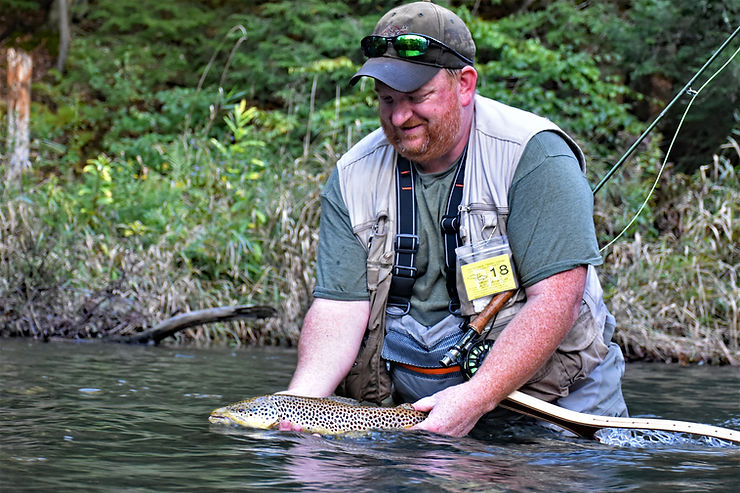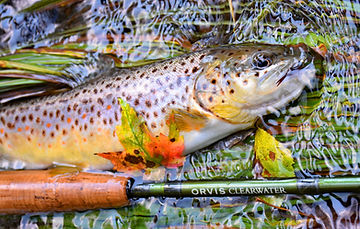Fall Brown Fever

I’ll admit, I’ve caught the fever. I’m obsessed with big brown trout, and there’s no better time to catch them than in the fall when the majority of people have turned their attention to hunting or sitting at home watching football. But don’t forget fall fishing. This is when brown trout spawn, after all. They leave their comfortable lairs and migrate to their spawning grounds, and along the way they get awfully hungry.
But that doesn’t mean they’re easy. One of the best tactics to keep in mind when targeting big fish this time of year is stealth. It doesn’t matter what rod, flies, or latest equipment you’re using, if you don’t tread lightly, you may as well go home.
Big fish get big for a reason. Their instincts are hyper-sensitive, especially as they move upstream into unfamiliar waters and must keep an eye out for predators. Keep a low profile while approaching the water’s edge.
When I get up on a pool, I resist casting right away. I like to wait and watch a short while before doing anything. Sometimes trout can sit right up next to the bank, or hover in the shadows, and if I can spot the fish before it spots me, I’ve increased my chances. I now have a target and can plan my approach.
Granted, most of the fish you catch will be from deeper water where you won’t be able to identify the trout or even know one is present until you hook into it. But migrating fish are strange. They can show up in odd places at odd times and occasionally in water barely deep enough to cover their backs.
Last fall, I was fishing a nice stretch of stream in late October and felt something bump up against my ankles. When I looked down, I locked eyes with a 16-inch, orange-bellied brown that darted for cover the moment it realized its mistake. Like I said, they’re strange. One minute they’re ultra spooky and the next they’re swimming right into you.
Water can be low and clear in October, but temperatures drop to spring-like levels, which gets fish active. Mornings, evenings, and overcast days are my favorite times to fish and will produce the most consistent results. However, I often find myself watching the weather forecast and planning my fishing days accordingly. No, I’m not a fair-weather fisherman. Quite the contrary. I love those dark, dreary, rainy fall days because that’s when my chances at a big brown are best.
A little murkiness to the water allows me to get closer to the holding water and work it over more methodically, usually with a shorter line. I like to hit all the pockets and nooks and crannies that I can’t hit when the water is low yet are perfect feeding lies for big trout. Fish move into these ambush locations during murky conditions because they feel safer than when the water is clear. As the water begins to clear, trout tend to sink back to deeper haunts.
Also, rising water gets fish moving. Browns and other migrating fish tend to travel most during times of fluctuation, which means that a pool that was void of trout yesterday could be a hot spot the day after a downpour. There’s a fine line, of course. Too much rain can blow out a stream and create unsafe wading conditions, and no trout is worth risking your life over. However, as soon as the water starts to recede can be a fantastic time to rip a streamer through your favorite pool.

Almost any fly that worked in the spring or summer will also catch fish in the fall. I let water clarity dictate how aggressive I get with fly selection. Clearer water usually means I start with scaled down streamers, size 8 or smaller. Drab colors and simple patterns have accounted for a lot of nice fish for me.
In murky water, bigger and flashier will work. In the fall, there’s usually more debris in the water, such as leaves and other particles, and when added to murky conditions, trout can have a hard time distinguishing food. In these conditions, big, flashy streamers are my favorite patterns.
More important than what you use, though, is how you present the fly to the fish. Lining a fish will spook it more than showing it the wrong pattern.
Don’t overlook dry flies this time of year, too. Many Pennsylvania streams have notable Blue-Winged Olive hatches. I’ve also fished various colors and sizes of caddisflies with great success in the fall, even during periods when no flies are emerging. Something all fall dry fly fishing seems to have in common is that the flies are tiny, size 18 and smaller. There are so many variations from stream to stream, though, that it’s always a good idea to check with your local fly shop to see what’s working in your area.
The most exciting part of fall fishing is the unexpected. Once big browns get moving, you never know where they’re going to show up – or when.
Sign up for the Dark Skies Fly Fishing e-newsletter
It's free, delivered to your inbox approximately three times each month. Your information is always kept private and used for the sole purpose of keeping you up to date on blog posts and specials in the online store.
Sign Up Now
